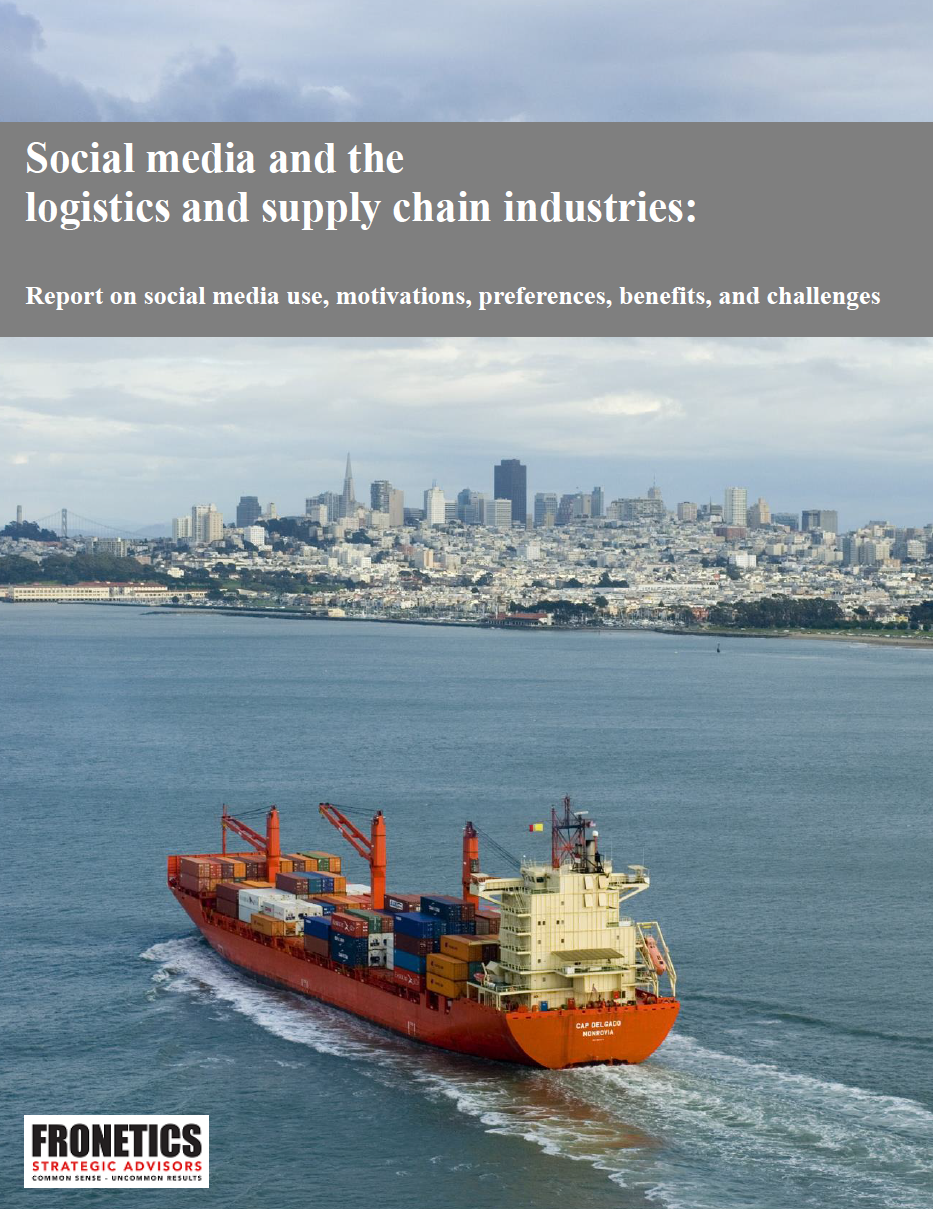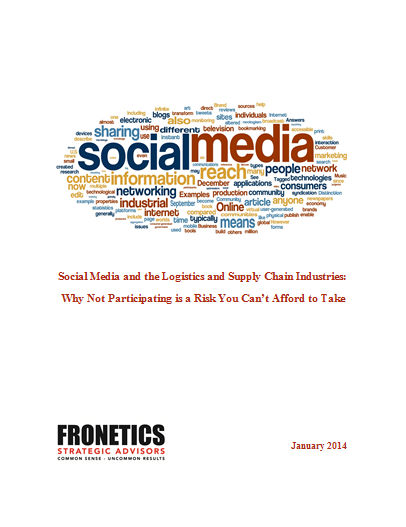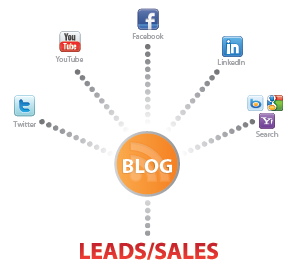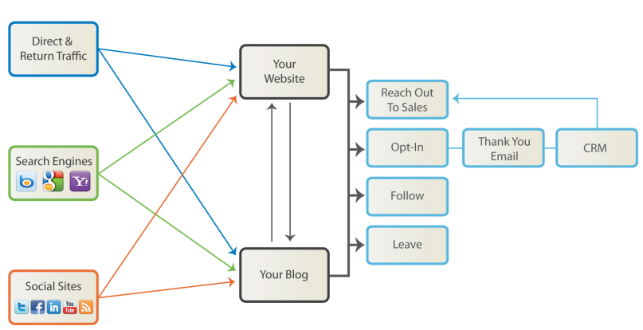
by Fronetics | Oct 28, 2014 | Blog, Marketing, Social Media, Supply Chain

A recent survey conducted by Fronetics found that the three biggest challenges faced by companies within the logistics and supply chain industries with respect to their social media use are: time (48 percent), money (43 percent), and a lack of strategy (33 percent).
How can companies overcome these challenges? Here are some suggestions.
Overcoming time constraints
Prioritize and be data driven. Track and measure your marketing metrics. Which efforts are driving the right traffic to your website? Which efforts are resulting in lead generation? Customers? If there are areas where you are focusing time and money, but are not yielding results – either rework your strategy, or eliminate them.
Fronetics’ survey found that 77 percent of companies within the supply chain and logistics industries use Facebook. However, only 15 percent reported Facebook to be very impactful with respect to their business and only 35 percent reported it to be somewhat impactful.
If your efforts aren’t paying off – don’t waste your time. Prioritize.
Tackling the budget issue
Data and setting priorities are important here as well. Together they can make the use of time and resources more productive.
Another thing to consider is whether it might be more cost effective to find an outsource partner.
Creating (and sticking to) a strategy
Strategy is essential. A 2014 study of B2B marketers found that a strategy is a key to success. Companies with a documented strategy in place were found to be more likely to consider their efforts to be effective than companies who do not have a documented strategy in place (60 percent vs. 11 percent).
Put someone in charge of developing a strategy and give the person the authority to make sure that it is carried out. If you are struggling with the “how,” ask for help. Here’s a great eBook that walks you through how to put a strategy in place. Alternatively, find a partner who can help you design a strategy that will work for you (and the time and money you have available).
To learn more about social media and the logistics and supply chain industries, download the report.


by Fronetics | Oct 28, 2014 | Blog, Marketing, Social Media, Supply Chain

A recent survey conducted by Fronetics found that the three biggest challenges faced by companies within the logistics and supply chain industries with respect to their social media use are: time (48 percent), money (43 percent), and a lack of strategy (33 percent).
How can companies overcome these challenges? Here are some suggestions.
Overcoming time constraints
Prioritize and be data driven. Track and measure your marketing metrics. Which efforts are driving the right traffic to your website? Which efforts are resulting in lead generation? Customers? If there are areas where you are focusing time and money, but are not yielding results – either rework your strategy, or eliminate them.
Fronetics’ survey found that 77 percent of companies within the supply chain and logistics industries use Facebook. However, only 15 percent reported Facebook to be very impactful with respect to their business and only 35 percent reported it to be somewhat impactful.
If your efforts aren’t paying off – don’t waste your time. Prioritize.
Tackling the budget issue
Data and setting priorities are important here as well. Together they can make the use of time and resources more productive.
Another thing to consider is whether it might be more cost effective to find an outsource partner.
Creating (and sticking to) a strategy
Strategy is essential. A 2014 study of B2B marketers found that a strategy is a key to success. Companies with a documented strategy in place were found to be more likely to consider their efforts to be effective than companies who do not have a documented strategy in place (60 percent vs. 11 percent).
Put someone in charge of developing a strategy and give the person the authority to make sure that it is carried out. If you are struggling with the “how,” ask for help. Here’s a great eBook that walks you through how to put a strategy in place. Alternatively, find a partner who can help you design a strategy that will work for you (and the time and money you have available).
To learn more about social media and the logistics and supply chain industries, download the report.


by Fronetics | Sep 9, 2014 | Blog, Marketing, Social Media, Strategy, Supply Chain

Many companies within the supply chain industry do not participate in social media because “they can’t get past the word ‘social’ and the perception it creates.” Companies with this mindset are at a disadvantage.
The supply chain industry is, by nature, an industry that is built on relationships, partnerships, cooperation, networks, and on communication. Being social is vital to the success of companies with the supply chain industry. Social media is a platform that is well poised to meet the needs and demands of the supply chain industry – and to help companies within the industry grow their business.
Social media is a tool that can be used be the supply chain industry for: risk management, business intelligence, recruitment, lead generation, engaging with current and prospective customers, attracting new customers, improving productivity, problem solving, and establishing your company as an industry leader. Moreover, social media can be used as the foundation for a new business model.
Clara Shih, CEO and Founder of Hearsay Social, and Lisa Shalett, Managing Director and Head of Brand Marketing and Digital Strategy at Goldman Sachs, write:
Social media is perhaps best thought of as a set of new and innovative ways for businesses and customers to do what they have always done: build relationships, exchange information, read and write reviews, and leverage trusted networks of friends and experts.
Similarly, Tony Martins, President of Tony Martins & Associates, notes that:
Supply chain executives should look at the social model of collaboration that can be enabled through social media as the most significant strategic weapon in supply chain optimization today. It liberates them from the rigid framework of functional structures and client-supplier relationships. It is the best way I’ve seen to keep the supply chain moving quickly, in spite of the many problems that will always occur.
Still skeptical? Look at companies who have successfully leveraged social media. Or, as Shih and Shalett suggest: “As you contemplate the risks and rewards of social media, we would suggest that the key ingredient for evaluation is simply to experience it for yourself.”
Interested in learning more about social media and the supply chain industry? Download our white paper: “Social Media and the Logistics and Supply Chain Industries: Why Not Participating is a Risk You Can’t Afford to Take.”

by Jennifer Hart Yim | May 6, 2014 | Blog, Content Marketing, Marketing, Social Media, Strategy
This is the second in a series of blog posts written by Adam Robinson, Director of Marketing at Cerasis. Founded in 1997, Cerasis is a top freight logistics company and truckload freight broker.
#1: What are your Marketing Objectives?
The following were the marketing objectives we decided for the Cerasis marketing strategy:
- Create a consistent marketing program of brand awareness campaigns and multi-channel marketing platforms in order to gain leads and sales from a more sophisticated and larger shipper.
- Achieve market perception as a thought leader in the logistics industry through consistent content marketing.
As part of our strategic plan, the Cerasis website and blog is the hub of the entire process. Every marketing element’s purpose is to (a) build brand awareness, (b) build community, and (c) drive traffic from those elements to the blog and website. This is important for several reasons:
- We are in total control of our website content, messaging, and engagement.
- Our blog and website is the best place for inbound lead generation.
- Blog content lasts longer than posts within the realm of social media and other traditional channels such as advertising in a magazine.
- A blog is the best place for sharing your story and showing expertise.

#2: Understanding Content Marketing and the Approach
Consumers of any product or service work through a process that starts with becoming aware of a need and ends with making a decision to purchase or not to purchase (Universal Marketing Funnel). Because of our marketing efforts, at any given moment in time Cerasis will have potential customers considering our company within various stages of the decision process. Our content marketing strategy will focus on building content that communicates with these prospective customers no matter where they are in their decision journey with Cerasis.
- Awareness – This is the stage in which a potential customer becomes aware that your company exists. Of the content you create, 30 percent to 40 percent will be for the purposes of awareness — making potential customers aware of your company and exposing you to your target market. Awareness content focuses on trends, education of best practices, and is completely devoid of over salesy messaging.
- Evaluation – This is the stage in which potential customers are in the market for what you are selling and they are trying to formulate their buying criteria. Like the awareness stage, 30 percent to 40 percent of our content will be focused on helping the customer evaluate your offering. Try and create content which evaluates your type of business vs. another. Another good example is iPhone vs. Android.
- Decision – Decision-based content that communicates why a customer should buy from Cerasis will represent about 20 percent of our content strategy. This kind of content is not overtly salesy, but is in line with your strengths and unique selling proposition
- Fanatic – This is content that is mostly user generated from your customer base and brand loyalists. These are in the form of testimonial, case studies, and guest blogs. This kind of content is about you, but from someone else’s perspective.
#3: Target Audience Establishment and Research
Of course if you want to even have results in social media and content marketing, you have to understand who you are trying to reach. It’s important to think holistically when considering who you are trying to reach at a potential prospects’ company. Typically, your target audience falls into two categories: Primary (decision makers) and Secondary (influencers of the decision maker), but there could also be Tertiary (these are the vetters; admins, executive assistants, and those gathering info to present to the group, usually in a B2B environment).
When thinking about your target audience, think of the following:
- Broad Categories: Think of the different verticals you can support. For example, a logistics company may want to reach those in the industries of Manufacturing, Supply Chain, Logistics, Transportation, Distribution and Freight. Let the categories be your guide for when you are joining digital communities or writing content you will then distribute in these communities.
- Job Titles: Next, ask the sales staff who they typically must talk to in order to get a signed contract. Typically, the person who signs the check, or the contract, is in leadership and makes the ultimate decision. This may be a CFO of a manufacturing company, or a Manager of some sort. Then, ask the customer service reps who fulfill your service or product offering who they deal with at your customers’ companies. For example, it may be Account Manager. Then, finally, continue to ask if there are other job titles that make sense. You can use these job titles to find communities easily on LinkedIn.
- Search Engine Key Phrases: To complete your list of your target audience, next go to Google.com and search some of these job titles to find related job titles, which you can find at the bottom of the search page. You may also use Google’s free Keyword Tool, plugin the job titles, and see related key phrases to those job titles.
More Action Items with this information:
- Start researching what kind of content is relevant to these job titles and industries in preparation for your content planning session
- Identify popular news sources, people, and blogs from which you may draw inspiration, establish key relationship for future guest blogging or networking, and of course in curation of content of value to your target audience to spur community growth and engagement in platforms such as LinkedIn, Facebook, Google+, or Twitter.
#4: Understanding Digital Assets, Social Media Platforms, and Online Communities Activation
Digital Assets
Digital assets are online environments you create from scratch. Digital assets are often created using a technology framework, a hierarchy of navigation, your company logo and custom graphics, and professional copy writing. The major digital assets you should consider when getting ready to activate your content marketing strategy are Website, Company Blog, Landing Pages, Videos, Podcasts.
Social Media Platforms
In general, most social media platforms you set up require you to amass a following in order to be effective. There are some platforms where the entire reason you establish it in the first place is to build followers, and then add value in the way of posts or messages or use to distribute your original content in order to lead back your desired target audience to your digital assets in order to gain awareness and inbound leads. The following are the major social media platforms, what they are, and what they may be used for:
- LinkedIn Company Page: A LinkedIn company page allows you to post information about your company such as founding date, about section, post location information, hours, products and services, job postings, and allow employees to list the company page within their own individual profiles. The page is used for marketing by accruing followers and post messages, such as your own original content, which reach those followers. LinkedIn offers great analytics around how many people were reached with your posts, how many clicks you receive, and how many followers you have gained over time. Company pages are a great way to find out company intelligence such as key decision makers.
o USES: Typically, a LinkedIn page is most effective in a business-to-business environment, as the mindset of the users on LinkedIn are for either finding jobs, finding information on their industry of choice, or consuming content distributed or curated by companies. Aid in the vetting process of potential clients who look up your company via search engines or LinkedIn search, aids in establishing credibility with target audience, reach your followers through consistent, relevant, and remarkable content, promote products and services, stay in touch with employees
- LinkedIn Profile: LinkedIn gives you the keys to controlling your online identity. Have you Googled yourself lately? You never know what may come up. LinkedIn profiles rise to the top of search results, letting you control the first impression people get when searching for you online.
o USES: Again, a profile, when used for digital marketing, is friendlier in a B2B environment, over a business-to-consumer (B2C) geared marketing campaign. The LinkedIn profile allows you to build awareness of yourself and company through consistent posting, serve as a repository for your own personal brand, join LinkedIn groups through your profile, search engine optimize your profile for increased visibility, gain valuable market insight through LinkedIn Today, build connections with your desired target audience
- Twitter: Twitter is an information network that brings people closer to what’s important to them. Every day, millions of people turn to Twitter to connect to their interests, to share information, and find out what’s happening in the world right now. Anyone can read, write and share messages of up to 140 characters on Twitter. These messages, or Tweets, are available to anyone interested in reading them, whether logged in or not. Your followers receive every one of your messages in their timeline – a feed of all the accounts they have subscribed to or followed on Twitter. This unique combination of open, public, and unfiltered Tweets delivered in a simple, standardized 140-character unit, allows Twitter users to share and discover what’s happening on any device in real time.
o USES: Think of Twitter as a consumption platform. Consumption of industry news and original opinionated content. In this way, it is great for B2B marketing. If using for B2C, it works well to extend brand affinity by creating campaigns or using branded hashtags for those who want to follow your company. Unlike a LinkedIn company page and a bit different than requesting a LinkedIn connection, you can follow other thought leaders, or those in your target audience to elicit a follow back. Additionally, Twitter is highly searchable via key word to find and follow those in your target audience or those talking about your products and services. Furthermore, Twitter aids in Search Engine Optimization through sharing your content, show thought leadership and attract your target audience by using strategic hashtags and curating industry news, consume industry news gaining valuable insights, gain inbound leads via content marketing by tweeting your original content, gain followers to increase brand awareness and chances of inbound leads
- Facebook Page: A Facebook Page, much like a LinkedIn Company Page allows you to include your company information, match your graphics to your website, include store locations, hours, mission and value statements, and categorize your business. In order to amass a following people must “Like” your page. Once they do, you can then hope to reach them with your posts. Unlike LinkedIn however, Facebook posts from a page only reach 10-16% of those who “Like” your page, thanks to Facebook’s “Edge Rank” an algorithm designed to declutter your personal Facebook Feed when you login.
o USES: Facebook often times is leveraged in a more B2C environment, but can be wildly successful in B2B if you know the power of a business Facebook’s ability to “Like” another Facebook business page, and thus still receive the posts from the page, hopefully reaching your desired target audiences. Furthermore, you can use Facebook to create Events, which you can promote and gain RSVPs, you can run contests via Facebook ads to increase awareness of your brand, curate and post original content to show your thought leadership, leverage the Facebook Ad platform to target Facebook users who are within your target audience with great precision, and ultimately, through pictures and video, you are able to show the personality of your business via Facebook.
- Google+: Is a social network owned by Google. If you have a google account, you already have a Google+ profile. There are Google+ individual profiles and Google+ Pages. Google views it as a social layer to compliment it’s other products of search, advertising, Gmail, maps, and Google Places (local listings). With a profile or a page, you can amass “Followers” here as well, whenever another Google+ user adds you to their circles.
o USES: Google owns Google+, so you must understand if you are wanting to have success in search engine optimization, Google+ is a must. Like a Facebook Page, you can post to your followers and they can see your posts, and +1, comment, or share on that post. The more +1s you have on your own content the more Google sees your content as trustworthy, thus uplifting your overall SEO efforts. This platform also allows you to fill in your company information, like a LinkedIn Page or Facebook Page, but here you can also connect your Google Local listing (formally known as Google Places) to your Google+ page to aid in further SEO, but also so customers may easily leave reviews and other potential customers can see your information and reviews all in one place. Finally, with a Google+ profile you can add Authorship, so that when your content does show up in search engines, your listing in the search engine stands out and increases the likelihood someone will actually click on it, as you see to the right.
- Pinterest: Pinterest is a fairly new social media platform, having come to prominence in late 2011. Pinterest allows you to create both a personal user account, as well as a business account. Pinterest is very similar to Twitter in that you can create a page and curate content. Except, instead of being driven by links and text, Pinterest is driven by images and video. A page or user can amass followers, and like twitter can follow those in your target audience to hopefully gain a follow back. One may pin your own original content or thought leadership content in the hopes to reach your target audience where they either repin or pin your content, like, comment, and more importantly click on your content.
o USES: Increase Search Engine Optimization by posting your blog and website content, build a community of followers made of your target audience, and display content in a more visual format
- YouTube: This is another platform owned by Google, and also very important in search engine optimization. Again, like many social media platforms, you are allowed to either be a user or have a company YouTube channel. As a company you can establish your channel and upload videos of original content, as well as fill out information about your company. You are able to amass subscribers and subscribe to other channels of interest. Additionally, your videos can gain likes and comments, and you may add descriptions to each video.
o USES: YouTube has applications in both B2B and B2C, and doesn’t require a lot of upkeep or posting, like some of the other platforms. YouTube primarily, in a B2B setting is used to increase search engine visibility with targeted key phrases in each video, gain subscribers of your target audience, and allows you to embed video in your digital assets as a way to make your marketing message stand out.
Online Communities
Finally, we come to online communities. Unlike digital assets and social media platforms, online communities allow you to tap into your target audience and not be at the mercy of having to amass followers or attract visitors to your brand. I am not saying you should not try and attract members of the community to your company, but you can think of online communities where you can use content of relevancy as bait to reel them back into your own controlled environments and established pages in order to support your overall marketing and business goals as laid out in your digital marketing plan. The following are the main online communities which give you broad reach:
- LinkedIn Groups: LinkedIn Groups are communities you may join within LinkedIn with your LinkedIn profile. You may search out LinkedIn groups by key word and decide to join as a member. LinkedIn will tell you the size of the group, the description, the rules of the group, who are the managers, and even the stats. You are allowed to post discussions, comment on others discussions, and after some time, post original content as you build up your influence in the group.
- USES: Increase the awarenes and raise the profile of yourself and your company through relevant discussions and engaging with other group members, gain traffic to your blog and website by posting original, relevant, and not too salesy content, increase connections with other LinkedIn users in your desired target audience, leverage deep search capability to find discussions around your products and services solutions, potentially reach hundreds of thousands of people in your target audience by joining up to 50 groups made up of your target audience.
- Google+ Communities: Google+ Communities are fairly new, but act very much like LinkedIn Groups. You can join strategic groups found by key phrase and post messages in them. You can engage with other members and add targeted users you may want to talk further with to your circles.
- USES: Primarily used to aid in SEO by posting links to your original content, allows for broad reach of your content and brand through reaching large numbers of people in each group
- Quora: Quora is a question and answer site where you can search by specific key word as well. You have to be a member, and it’s as straight forward as someone asking a question, and people offering their expert answers. Other users will then vote on the answer with the best ones being featured.
- USES: The first thing you DON’T want to do is SPAM Quora. This is the place where you simply want to provide value by answering questions related to your expertise. If it makes sense, you can post a link to your content, but this is highly frowned upon unless it truly adds value (this is why proper content marketing where you lead with value is SO IMPORTANT! More to come in future blog posts!). Once you add value and build out your influence, you can be known as “That person” who is the expert. And who doesn’t want to do business with an expert!
- Reddit: Reddit is a fantastic community, but the challenge is how large it is. Like LinkedIn Groups, there are several niche places, called subreddits, where you can simply search for your industry and post your content to. Again, like LinkedIn groups, if you don’t want to be spammy in nature, you have to be relevant and engaging. Don’t over post here, but try a piece of content once per day.

by Jennifer Hart Yim | May 6, 2014 | Blog, Content Marketing, Marketing, Social Media, Strategy
This is the first in a series of blog posts written by Adam Robinson, Director of Marketing at Cerasis. Founded in 1997, Cerasis is a top freight logistics company and truckload freight broker.
The purpose of this series of blog posts is to give others in our industry and especially those in the manufacturing industry, a guide to create an effective digital, social media, and content marketing strategy which will produce results for your company. If you have followed the Cerasis blog since its launch in March 2013, you have noticed that we work really hard at executing our strategy. The reason we work so hard is because we are passionate about educating the marketplace on information that matters to them. In that way, we want to be the de facto expert in the manufacturing and logistics industries. If we can help those who are our customers and potential customers (manufacturers and distributors) with best practices around logistics and freight, as well as manufacturing industry news, we are continuing our mission of driving long term value (even if we give the information away for free). The result (we hope and have seen) is that people view us as the expert and will want to engage us in a long term relationship as their logistics services provider. We hope this is helpful and you learn something from it!
Background of Cerasis use of Content Marketing and Social Media
- Company started formal marketing for the first time in October 2012, its 16th year.
- Little brand awareness, not thought of as a thought leader, but company still grew well by referral.
- It was important for us to establish our messaging, our target audience, and how we were going to best market the company.
- We didn’t have any budget for advertising, and with the rise of content marketing, we knew it was important to use social media and content as a way to start marketing and fine tuning the messaging of the company.
- We finished our market research phase (tips below on how to conduct one), and knew the content and who we wanted to reach.
- We then looked at all the social media channels and decided which platforms to use and what online communities to join.
- We built a strategy and started executing our content by simply posting one piece of content every business day.
Digital Marketing Strategy Approach for Cerasis
There is a process to strategic planning in order to lead towards sustainable marketing programs which yield a tangible return-on-investment (ROI). The process starts with understanding where social, digital, content, and traditional marketing fits in the world of inbound lead generation and increased brand awareness.

The goal of any strategic plan should be to find and acquire new customers and to grow existing customer relationships. The map on the next page shows how customer engagements happen online and in general. This map to the left helps us determine Cerasis’s route, analyze where we currently are, and hone in on where we should focus our attention to keep the strategy on track.
So, what are all the results from our social and digital marketing you ask?
Cerasis Quick Stats (Sept 12 to March 14)
- All Visits to Cerasis.com: 4,476 to 34,461 (669.91% Increase)
- Blog Visits: 0 to 28,271 (notice how without our content and social media, we would not have grown our website visits to where they are today)
- Social Media Visits: 4 to 8,546 (214,550% Increase)
- Search Visits: 711 to 16,275 (2,189.03% Increase)
- Social Community: 175 users total to 9,635 users total
- Twitter: 0 to 2,760 Followers
- FB: 0 to 492 Likes
- LinkedIn Group Members: 0 to 3,550
- LinkedIn Profile Connections: 120 to 1,456
- LinkedIn Company Page Followers: 51 to 529
- Google Plus Followers: 0 to 662 and over 310,000 views of the Company Page
- Pinterest Followers: 0 to 188
- Engagement Numbers:
- Twitter Mentions/RTs: 14,825/5,721
- LinkedIn Group Comments: 12,766
- Facebook Comments, Likes, Shares: 1,484
- LinkedIn Page Impressions/Interactions/Clicks: 247,359/566/1,560
- Pinterest Impressions/Repins: 73,698/327
- Blog Comments: 841
- Google Plus +1s: 2,976
- Conversion data (note, leads vary based on industry; 1 sale for us can mean a lot of revenue)
- Leads From Search Engines: 71
- Leads From Social Media: 65
- Leads From Webinars: 52
- Total Customers Gained: 35
Conclusion
Social media, content, and digital marketing are much like the Pareto Principle: Focus on the platforms and entities which yield the highest results, don’t just do something or be somewhere to do it! It all comes down to strategy! Now, if you have the resources to be on every social media platform, you should, but only if you do it well!






